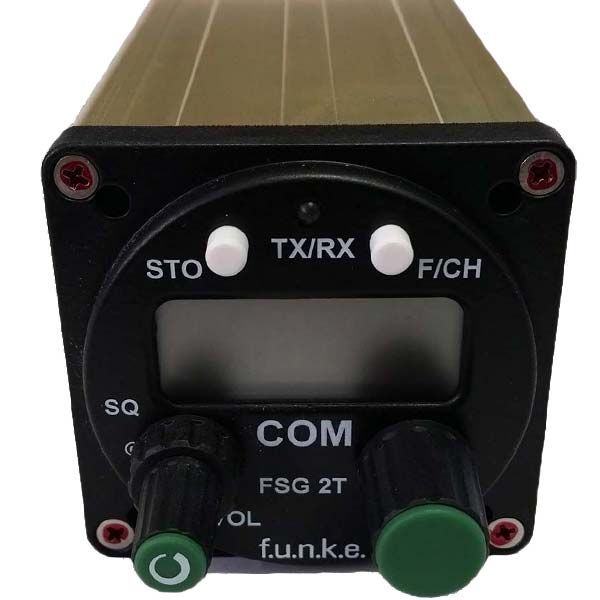f.u.n.k.e. FSG 2T VHF/AM Aviation Transceiver
Manufacturer Part Number: F10350
f.u.n.k.e. FSG 2T VHF/AM Aviation Transceiver
General Description
f.u.n.k.e. FSG 2T VHF/AM Aviation Transceiver - The FSG 2T VHF/AM COM is a miniaturized, lightweight, panel mounted (also for helicopters no shockmounts are required), single block transceiver operating in the VHF/AM airband radio frequency range 118.000 MHz to 136.975 MHz, providing 760 channels with 25 kHz channel spacing, covering a standard communications distance of ca. 100 NM (nautical miles) at FL 70.
The transceiver fits into a standard 2¼″ / 58 mm diameter instrument hole and is fixed by four (4) screws M4. Installation depth behind the front panel including connectors and wiring is 240 mm. Connections on the rear panel to the electrical environment are achieved via a locked Standard DB–15 male connector using a wiring harness, and a BNC antenna connector. All operational control and display elements are located on the night–design front panel: Transmit / Receive Mode, modulation level or Intercom is indicated by a 3-color Status signaling LED on the front panel. The back–lit Liquid Crystal Display (LCD) shows the active frequency, onboard supply or memory channel number as well as ERROR codes (if applicable).
W&W typically stocks Funke FSG2T Transceiver.


- VHF/AM airband transceiver
- Powerful single block transceiver approved for airborne operation in fixed wing and helicopter aircraft
- 5 Watt RF output power
- Memory for 20 channels
- Integral controls enable steady performance characteristics
- Compatible with CLIMAX (multi–carrier) operation
| Type | FSG 2T, article–number F10350 Amplitude modulated (AM) VHF Avionics Transceiver |
| Frequency Range | 118.000…136.975 MHz |
| Channels | 760 channels, 25 kHz spacing |
| Frequency Selection | VFO, digital |
| Frequency Display | 5 digit 7–segment LCD display (backlit) |
| Frequency Control | PLL frequency synthesizer, microprocessor controlled |
| Memories | 20, stored in a non–volatile EPROM |
| Exposed Dial Face | 57 mm / 2¼″ dia, fits into standard instrument hole |
| Overall Dimensions | W = 63 mm, H = 61 mm, L = 217.5 mm W = 2.48″, H = 2.4″, L = 8.6″ |
| Installation Depth Behind Panel | 240 mm / 9.5″ incl. 50 mm / 2″ for harness |
| Weight | 600 grams / 1.32 lb. without harness and mating plugs |














